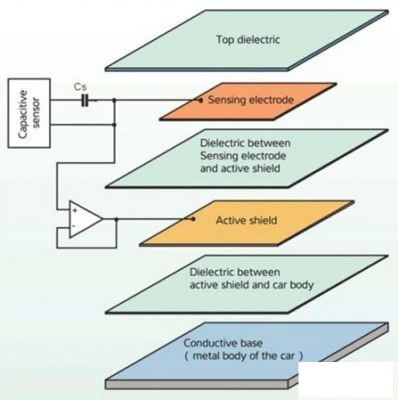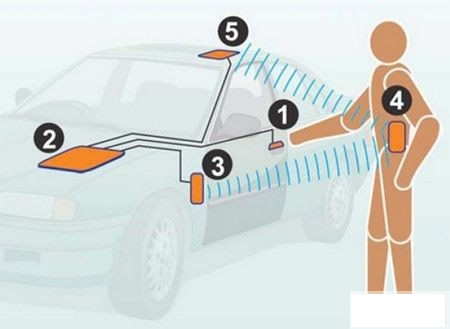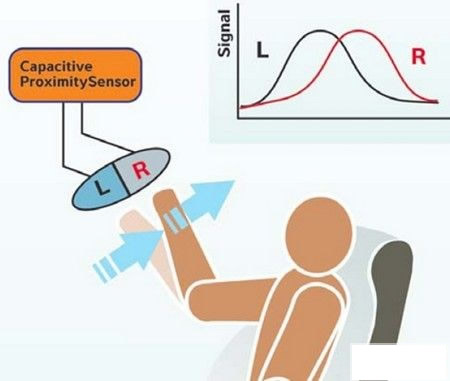The demand for proximity sensors has been steadily increasing in automotive electronics applications, and such sensors can reliably detect objects close to the sensor surface without physical contact. Probable detection of possible applications in the automotive electronics industry is limitless:
This article refers to the address: http://
• Car access control: The detection hand is close to the door handle, and then the unlocking process is started.
• Illuminate and wake up the touch screen when the palm is close to the surface of the screen
• Turn on/off the interior lights when the palm is close to the sensor
• Turn the device on/off by detecting the simple action of the palm in the air
• Detect large obstacles around the car during parking
There are now many different proximity detection methods, such as capacitive sensing, infrared, ultrasonic, optical, and so on. For proximity detection from 5mm to 300mm, capacitive sensing technology has many advantages over other technologies: excellent reliability, simple mechanical design, low power consumption and low cost. This article will discuss Atmel Corporation ( Atmel® Corporation's capacitive proximity detection technology.
Atmel is a leader in touch solutions with extensive experience in this field. Its capacitive sensors are based on the company's first charge transfer technology, which is when a particular control sequence is repeatedly applied to an I/O pin. A voltage is generated across the sampling capacitor. Atmel currently holds several patents for charge transfer technology for self-capacitance sensors (Atmel QTouchTM) and mutual capacitance sensors (Atmel QMatrixTM). Atmel's charge transfer technology offers users some important advantages over other capacitive sensing methods, including: higher reliability, high sensitivity, excellent moisture resistance, and noise immunity.
QTouch and QMatrix technologies are used in a variety of touch controllers that support touch buttons, sliders, trackwheels, and touch screens. Proximity testing can also be used with certain standard products. Atmel is developing and implementing new proximity algorithms to increase sensitivity and support finger or palm detection ranges up to 200mm or more. The new standard product and software library modules are scheduled to be launched in 2011 and 2012.

Figure 1: Effective shielding of proximity sensors
When the object approaches the electrode, the capacitive proximity sensor measures the change in capacitance between the single electrode and the ground (self-capacitance sensor), or between the two electrodes (mutual capacitance sensor). In this type of application, the capacitance is typically between 10pF and 300pF, and the change in capacitance is usually very small (several fF to a few pF). Since the electric field lines around the self-capacitance sensor diffuse farther from the sensing electrode, proximity detection prefers self-capacitance measurement rather than mutual capacitance measurement because the latter's electric field lines are mainly concentrated between the transmitting and receiving electrodes. within the area.
Features of automotive application capacitive proximity sensors:
High sensitivity: To detect small changes in the measured capacitance, the sensitivity of the sensor must be high and stable. Therefore, special measures should be taken to reduce the negative impact of the capacitive load on the sensitivity, especially when the sensing electrode is placed on a conductive surface (such as a metal plane, a car body, etc.). This reduces the negative effects of capacitive loading by adding an effective shield between the electrode and the conductive surface (see Figure 1).
A further advantage of active shields is their neutralizing effect on water films.
Another advantage of an effective barrier is the ability to create a neutral effect with the water film.
• Moisture resistance: Measurement signal changes caused by moisture are more pronounced than measurement signals generated by close objects. For capacitive sensing methods, the water film on the surface of the object is one of the biggest problems. The conductivity brought about by the water film causes a change in the measurement signal, and this change is similar to the change caused by the normal touch.
There are two main ways to deal with water film effects:
1. Use an effective shielding layer (described above)
2. Shorten charge transfer time: The water film can be viewed as a decentralized RC circuit (see Figure 2). Reducing the charge transfer pulse will prevent these distributed capacitances from being fully charged, thereby reducing the effects of the water film. The best results are obtained if the charge transfer time is controlled between 100ns and 250ns. The use of the right mechanical design in the sensing area and the use of suitable materials can prevent the appearance of thicker water films.

Figure 2: Water film equivalent to a decentralized RC circuit
• Temperature stability: In automotive applications, extreme temperature changes can occur at any time, so special attention should be paid to the stability of the mechanical design. Otherwise, even a very small gap change near the conductive surface may lead to false detection.
• Noise immunity: Due to the high sensitivity, noise interference can affect the operation of the proximity sensor. The mechanical and electrical design of the PCB circuit should avoid noise interference from adjacent cables or conductive surfaces.
• Fast response: The response time is typically between 10ms and 100ms.
The application details of capacitive proximity detection in the automotive field are discussed below.
Car access control system
An example of capacitive proximity detection is the application in automotive access control systems (see Figure 3). A proximity sensor that detects the proximity of a human hand is located in the door handle (1). Upon detecting the proximity of an object, the main control unit (2) sends a wake-up signal via the low frequency antenna (3); this signal activates the car key transmitter (4). The car key transmitter then exchanges information with the RFID receiver (5); if the coded information matches the main control unit (2), the car door lock is opened. The entire process of proximity detection and ID identification is about a fraction of a second.
This means that when the door handle is pulled, the door lock is already open.
Compared to touch detection, the advantage of using proximity detection in a car access system is that it can preempt the time of identifying the owner, with the result that the door lock is already open before the door is pulled.

Figure 3: Door opening system with proximity detection
Detect space gestures to turn devices on or off
Using two or more capacitive proximity sensors simultaneously, you can turn the device on or off by detecting simple movements of the palm in the air, such as waving in front of the device being inspected. Figure 4 shows a simple example of using such a system to turn on/off the interior lighting of a car. Turning the light in one direction against the light is turning the light on, and waving in the opposite direction turns off the light. The system is capable of analyzing the signal of the proximity sensor, determining whether the gesture indicates to turn the light on or off.
There are many different ways to design a sensing electrode in an electric lamp, from the use of thin copper wire to the use of conductive polymers that can be directly attached to plastic.

Figure 4: Turning on/off the in-vehicle device by detecting the simple action of the hand in the air
in conclusion
• Automotive capacitive proximity sensors open the way for a wide range of comfort applications.
• Humidity and rapid temperature changes are major challenges for automotive capacitive proximity sensors, and Atmel's latest capacitive sensing innovations can solve these challenges.
Double wall electric water boiler urn
Double Wall Electric Water Boiler Urn
Double wall electric water boiler urn
FOSHAN FORTUNE ELECTRICAL APPLIANCE CO.,LTD , https://www.coffelady.com